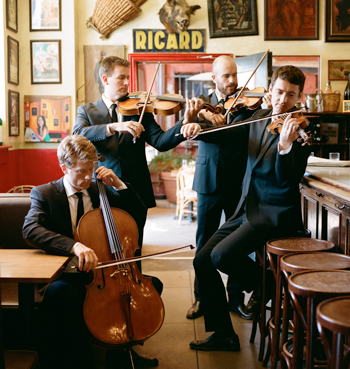by Daniel Hathaway
 Oberlin’s new quartet-in-residence through 2016 introduced itself with a lengthy but compelling concert on Tuesday, September 30 in Finney Chapel. The performance by violinists Benjamin Jacobson and Andrew Bulbrook, violist Jonathan Moerschel and cellist Eric Byers also launched this season’s Artist Recital Series.
Oberlin’s new quartet-in-residence through 2016 introduced itself with a lengthy but compelling concert on Tuesday, September 30 in Finney Chapel. The performance by violinists Benjamin Jacobson and Andrew Bulbrook, violist Jonathan Moerschel and cellist Eric Byers also launched this season’s Artist Recital Series.
The Calders, one of the few string quartets to have been formed on the West Coast (they originally got together at the Thornton School of Music at USC in Los Angeles), have a close relationship with such contemporary composers as Thomas Adés, Terry Riley and Christopher Rouse. As Andrew Bulbrook explained in his opening remarks, the quartet chose to open their Oberlin concert with Adès’s opus 12 Arcadiana and to follow it with a quartet by Leoš Janáček, a composer whose music Adès greatly admired.
Described in Peter Laki’s program notes as “a web of allusions — sometimes overt, sometimes more hidden,” Arcadiana comprises seven pastoral idylls in short movements that invoke fleeting references to a Venetian barcarolle; Mozart’s The Magic Flute; Schubert’s song, Auf dem Wasser zu singen; paintings by Poussin and Watteau; Elgar’s Nimrod variation; and Lethe, the river of oblivion in Greek mythology.
Adès, who wrote Arcdiana when he was 23, explored a variety of extended string techniques including woozy slides, snap pizzicati and glissandi, and created moods ranging from the sweetly sentimental (venezia notturno) to the dark and sensual (Et…tango mortale). The Calders played its hazy textures with intense concentration.
Janáček’s second quartet, subtitled “Intimate Letters,” reflects the extensive correspondence that grew out of the composer’s unconsummated love affair with a twenty-six year old married woman he had met at a spa in Moravia when he was 63. The quartet suggests in four wildly episodic movements the content of hundreds of letters that passed between the two over a period of years.
Mood changes abound as the music vacillates between beautiful lyricism and crazed outbursts, and ranges from noisy scratchings to alluring sweetness. The Calders cannily related these emotional swings to the work’s underlying structure, playing solos rich with narrative then suddenly coming together into a tight ensemble.
Franz Schubert’s famous “Death and the Maiden” quartet (No. 14 in d minor) followed intermission. Here, the Calders had the opportunity to demonstrate their fine sense of blend, unanimity of sound, and dynamic control in more traditional string quartet fare. In the second movement, the ensemble presented the front end of the Schubert song that gives the piece its subtitle with eerie austerity, then played each of the succeeding variations with an acute sense of their individual qualities.
If a bit of fatigue showed up during passage work in the final Scherzo, it did come at the end of a long evening. Schubert loves extended good-byes. He seemed not to be able to end this movement without finding just one more thing he wanted to say, but the Calders pressed heroically to the end, ending their Oberlin debut concert with an impressive, final flourish of energy.
The quartet will make its next appearance on November 18 at 8:00 pm in the more intimate space of Stull Recital Hall in Bibbins Hall at the Oberlin Conservatory. Faculty members Richard Hawkins, clarinet, and Michael Strauss, viola, will join the Calders in a free concert of chamber music by Brahms.
Published on ClevelandClassical.com October 6, 2014.
Click here for a printable copy of this article.


